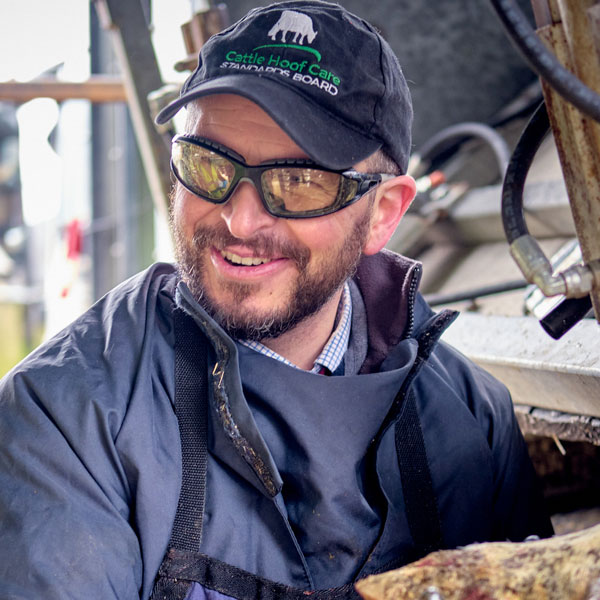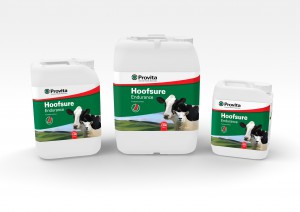Hoofsure Endurance
Product Description:
Provita Hoofsure Endurance is a unique scientifically formulated footbath solution containing organic acids, tea-tree oil and wetting agents. Its highly concentrated formula (1:100) means it can be used up to 500 cows passes in a 200 litre footbath.
With innovation at the heart of Provita, our dedicated Research & Development team have now developed a new improved formula. Utilising proprietary technology, the new formula is 33% faster acting and provides more contact time on the hoof.
When to use:
Dairy Cows – for maximum control use continually at every milking, minimum footbathing frequency is 3 times per week.
Sheep – footbath every 2 to 6 weeks depending on risk level.
Unit Sizes:
205 litre, 20 litre, 10 litre and 5 litre drums.
Number of application:
Hoofsure Endurance 20 litre is effective for up to 8,000 sheep and 5,000 cattle
Managing Lameness: Key tips from veterinary lameness specialist
Lameness is one of the most common debilitating health issues for dairy cattle. According to Cattle Health and Welfare Group Report (2018) approximately 30% of dairy cattle will be affected with lameness during their lifetime.
Several factors are associated with lameness in dairy cows including genetics, the environment and management. Management can be particularly important with low body condition score (BCS) and previous lameness events being major risk factors. There are four types or causes that lead to most dairy lameness issues: digital dermatitis, sole bruising, sole ulcers, and white line disease. Digital dermatitis is an infectious disease caused by bacteria called treponemes, spiral-shaped microorganism found on most dairies around the world. Classical signs of this painful disease include raw, red, oval shaped lesions typically found on the back of the cow’s heel but they can appear as a range of warty or scabby lesions on the skin of the foot. Often lots of interdigital growths is what is seen first. Outbreaks happen mostly when animals are in consistently wet and dirty conditions. Digital dermatitis has significant economic impacts on the dairy with an estimated cost per case of approx. £80 and often affecting around 40% of cows in the herd. This does not include lifetime effects such as development of other lesions like and necrotic hoof lesions either as these are yet to be fully defined by the industry. While there is no method of eradicating this lameness causing disease, digital dermatitis can certainly be managed if you know what to look for.
Focus on Dry Cows and Heifers
Quite often the simplest and most effective digital dermatitis control starts with heifers and dry cows. Many farmers can control this disease very well in the milking herd, but if you have heifers and dry cows coming in with fresh active lesions, then you are continually introducing new cases into the milking herd. Unfortunately, if an animal has digital dermatitis early in her life, it will most likely continue to affect her as she enters the milking herd. Renowned cattle lameness researcher Dr Arturo Gomez has published research showing that if heifers have no digital dermatitis pre-calving about 80% of those stay infection-free into the next lactation. On the other hand if animals have one case of digital dermatitis pre-calving, about 50% become repeat offenders. Gomez went on to show that if heifers have multiple cases of digital dermatitis pre-calving, then about 70% of them repeatedly get cases during the first lactation. Additionally they will produce a lower milk yield in the first lactation and be at increased risk of early culling from the herd.
A study in the UK by Dr Laura Randall and others (2017) highlighted that animals with previous lameness issues were more likely to be affected. They showed that approx. 80% of lameness cases could be contributable to a reoccurring issue and concluded that repeated bouts of lameness made a large contribution to the total number of lameness events in the studied herds. Randall and co-workers surmised this could be because certain cows are initially susceptible and remain susceptible due to the increased risk associated with previous lameness events or due to repeated interactions with environmental factors.
Prioritise Feet Hygiene
To prevent digital dermatitis from occurring in the first place, the focus should be on hoof hygiene. The whole herd goal of preventing digital dermatitis is to create clean, dry feet. This means it is important to look for manure pooling in walkways where animals are constantly standing and to use a proper footbath system. When utilising footbaths, it is important to aim for an appropriate contact time with a well-constructed and well-positioned footbath, with a proven footbath product for the solution in it.
Foot baths are prevention, which is better than cure
Once an animal is infected with digital dermatitis, she will carry the disease with her for the rest of her life. One way to manage this is through proper footbath use and identifying active lesions for timely treatment. The goal is not to focus solely on treatment but to prevent NEW INFECTIONS by disinfecting feet, ideally every day if not every milking. Cows with active lesions can be identified and promptly treated to reduce the pain and send the lesion in a healing state that does not infect other healthy feet. Foot bathing also appears to help keep infected cows free from infection if done properly at the right concentration of product.
Using the footbath will require some tinkering and adjustment at various times throughout the winter period, and indeed the whole year. It is almost like treating the footbath like a dial, where at certain times you will need to increase or decrease the footbath solution concentration and frequency of use to match the level of digital dermatitis in the herd. Therefore monitoring and management of digital dermatitis on a continual (weekly) basis will make it cost effective.
Footbath management
Some tips for best management practices for footbaths so it lends itself to being less of a chore and more a routine job:
- Use a well-designed footbath with adjacent mixing facilities. Long enough for 2-3 feet immersions so ideally around 3 metres long and 0.6 metres wide
- Provide a footbath at least every other day and adjust based on outcome to achieve a minimum frequency to maintain control
- Use an antibacterial with evidence of efficacy against digital dermatitis and other infectious lesions
- Use the solution as long as it is effective e.g. 150 to 500 cow passes for a standard 250 litre bath
- Footbath all cow and heifer groups
Alternatives to copper and formalin
Without doubt copper and formalin are the two most traditionally used footbath agents but each have drawbacks associated with them in terms of safety and legalisation.
Formalin chemically cauterises digital dermatitis wounds to help healing but general industry opinion is that it is not beneficial for acute active stage lesions. Importantly, it is classified as a probable (class 1b) carcinogen and should be handled in accordance with national legislation. Under UK law this means persons should be trained and wear the appropriate personal protective equipment.
Copper sulphate under EU biocide law is not permitted to be used in footbath solutions for animal use as it is an environmental hazard. Also copper can be quickly inactivated by footbath contaminants like manure and urine, meaning it has a low cow pass capacity for 150 or less unless you use an acidifying agent.
Hoofsure Endurance range

Dr Nick Bell states that Hoofsure Endurance is “the only product I’ve ever trialled that has performed as well as formalin at prevent new lesions, and I’ve trialled a lot of products”. Hoofsure Endurance is well placed to help dairy farms get on top of and control lameness. It is a proprietary footbath solution with over 40 trials across 3 continents. Notable research shows it is up to 44% more effective than formalin and copper sulfate with proven antibacterial activity*. Also Hoofsure Endurance will allow up to 500 cow passes through a 200 Litre footbath making it a very cost-effective solution! Hoofsure range also includes Konquest hoof gel and Combat hoof spray for individual hoof application.
Co-written by Dr Nick J. Bell MA VetMB PhD PG cert Vet. Ed. FHEA DipECAW BM(AWSEL) MRCVS and George Shaw, MPharm MPSNI.
*References available on request
